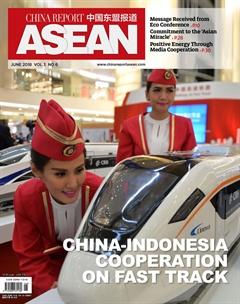A Vision of Cleaner Water
By Wang Fang
Originating in southwest China before meandering south across the border, the Lancang River is called Mekong as it flows through Myanmar, Laos, Thailand, Cambodia and Vietnam and empties into the sea. The water nurtures the millions living along its banks, makes a significant impact on their physical wellbeing and is indispensable in sustaining social and economic development of the six nations. Understandably cooperation between these countries in water conservation is particularly important.
Common Challenges
“The Lancang-Mekong is a transnational river that wanders through several territories, and it is imperative that we six nations work together to preserve the ecological health of the river so as to achieve sustainable development in the region,” asserted Tony Hell, secretary-general of Tonle Sap Authority under the Cambodian Ministry of Water Resources and Meteorology, at the Lancang-Mekong Roundtable Dialogue on Water Environment Treatment on March 21.
As developing nations, all of the countries along the Lancang-Mekong river have been facing serious water pollution challenges in the process of urbanization and industrialization.
“The Mekong has nurtured the Cambodian people for generations, but since we live along the lower reaches of the river, we are particularly concerned about water pollution, which we expect to be addressed through cooperation among six nations,” added Tony Hell.
The people of Myanmar have the same worry. When visiting the Beijing-based Lancang-Mekong Environmental Cooperation Center (LMEC) this March, an official media delegation from Myanmar expressed concern about possible water pollution caused by hydroelectric stations while recognizing that electricity is vital to the economic development of Myanmar.
The Lao stretch of the Mekong runs 3,800 kilometers, accounting for 35 percent of the rivers total volume at any given time. According to Somsanouk Phommakhot, director of the Soil and Water Pollution Division of Pollution Control Department of the Lao Ministry of Natural Resources and Environment, Laos faces multiple challenges when it comes to water pollution control, especially in terms of capacity building, talent, technology and equipment, so they are eager to cooperate with other countries along the river in this regard.
Cross-border cooperation is equally important to Vietnam, a nation of crisscrossing waterways covering 10,000 square kilometers. From the perspective of To Thuy Nga, an official from the Pollution Control Department of the Vietnamese Ministry of Natural Resources and Environment, most of the rivers across Vietnam have been contaminated, in large part due to pollution from industrial activity, fertilizer use and domestic waste. “In recent years, Vietnam has spared no efforts to improve its capacity in water pollution prevention and control in the Mekong basin, especially the Mekong sub-region, but transnational cooperation needs to expand,” remarked To Thuy Nga.
Diverse Approaches
At the Lancang-Mekong Roundtable Dialogue on Water Environment Treatment, representatives from the six countries discussed and shared experiences on water pollution control and other environmental protection issues.
Dr. Tin Aung Win, assistant director of the Environmental Conservation Department of Myanmars Ministry of Natural Resources and Environmental Conservation, explained that Myanmar formally launched water resources conservation policies in 2015 and has established a central committee to coordinate cooperation among related authorities. As a legislative measure, the “polluter pays” principle has effectively helped to control pollution. “A lack of technology and capability alongside a population boom and considerable industrial development in our country are the primary drivers of the water pollution,” he said. “Myanmar seeks to adopt international best experiences and best practices to help us formulate laws and regulations to cope with water pollution.”
According to Dr. Chao Nokyoo, director of the Inland Water Division of Water Quality Management Bureau, Pollution Control Department of the Thai Ministry of Natural Resources and Environment, water pollution in Thailand is mainly caused by industry, agriculture and domestic activities. The Thai government has promulgated a series of laws and measures to improve water quality. “In the next few years, greater efforts will be made to adopt a wide range of economic approaches such as taxation and the ‘polluter pays measure,” added the official.
Like other countries in the region, China has endured its fair share of environmental pollution problems. Over the past several years, China has made remarkable achievements in environmental progress and sustainable development, especially prevention and treatment of water pollution. At the Roundtable Dialogue, Zhu Xinxin, associate research fellow with the LMEC, elaborated on Chinese practices in water pollution treatment. After crafting sound legal framework, China has launched innovative approaches such as the river chief system. Currently, China is implementing Water Pollution Prevention and Control Plan for Major River Basins, which covers basins of the Yangtze, Yellow and Pearl rivers.
Founded on November 28, 2017, the LMEC is committed to promoting Chinese environmental concepts, improving environmental management capacity of countries along the river and contributing to sustainable regional development. During the Roundtable Dialogue event, LMEC officially cut the ribbon of its Yunnan Office. “This marks a concrete measure in implementing Lancang-Mekong environmental cooperation policies and building a cooperation platform for regional environmental protection,” declared Zhou Guomei, deputy director general of the LMEC, at the inauguration ceremony. “The LMEC Yunnan Office will capitalize on the geographical advantage of Yunnan as a border province to improve the Lancang-Mekong environmental cooperation mechanism.”
According to Guo Jing, director of the International Cooperation Department of Chinas Ministry of Ecology and Environment, by capitalizing on the respective advantages of the Lancang-Mekong countries, deepened cooperation among the six nations in environmental policy dialogue, capacity building and pilot projects, as well as the formation of a multi-dimensional cooperation mode across regional, national and local levels, will certainly contribute to the Lancang-Mekong cooperation and the sustainable development of the region.

